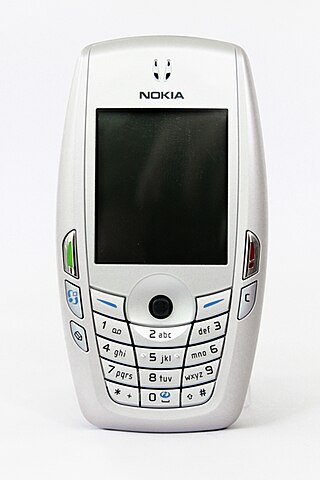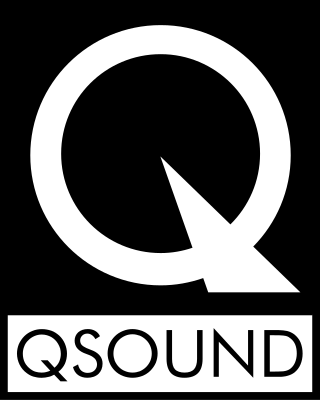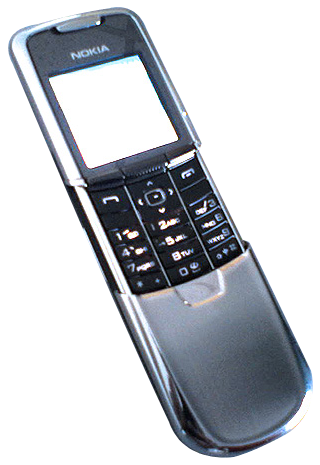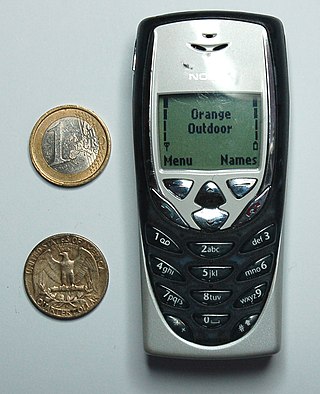
Thomas Morgan Robertson, known by the stage name Thomas Dolby, is an English musician, producer, composer, entrepreneur and teacher.
A ringtone is the sound made by a telephone to indicate an incoming telephone call. Originally referring to the sound of electromechanical striking of bells or gongs, the term refers to any sound by any device alerting of an incoming call.

The 6620 is a mobile phone created by Nokia, announced in 2005, running on Series 60 2nd Edition and the Symbian operating system. It was the first EDGE-capable phone for the Americas' market.

QSound Labs is an audio technology company based in Calgary, Canada. It is primarily a developer and provider of audio enhancement technologies for entertainment and communications devices and software. The company is best known as a pioneer of 3D audio effects, beginning with speaker-targeted positional 3D technology applied to arcade video games and professional music and film soundtrack production. QSound was founded by Larry Ryckman (CEO), Danny Lowe, and John Lees. Jimmy Iovine served as SVP of Music and Shelly Yakus as VP of Audio Engineering in its formative years.

The Nokia 3510 is a mobile phone for the GSM network, introduced by Nokia on 12 March 2002. The phone was the first Nokia phone to bring GPRS internet services to the mass market. It was also the first Nokia phone to ship with Beatnik's miniBAE engine, allowing for playback of polyphonic ringtones.
Mobile content is any type of web hypertext and information content and electronic media which is viewed or used on mobile phones, like text, sound, ringtones, graphics, flash, discount offers, mobile games, movies, and GPS navigation. As mobile phone use has grown since the mid-1990s, the usage and significance of the mobile devices in everyday technological life has grown accordingly. Owners of mobile phones can now use their devices to make photo snapshots for upload, twits, mobile calendar appointments, and mostly send and receive text messages, listen to music, watch videos, take mobile pictures and make videos, use websites to redeem coupons for purchases, view and edit office documents, get driving instructions on mobile maps and so on. The use of mobile content in various areas has grown accordingly.
The Nokia tune is a phrase from a composition for solo guitar, Gran Vals, composed in 1902 by the Spanish classical guitarist and composer Francisco Tárrega. It has been associated with Finnish corporation Nokia since the 1990s, becoming the first identifiable musical ringtone on a mobile phone; Nokia selected an excerpt to be used as its default ringtone.
Mobile music is music which can be transported, or in other words, mobile. The term itself is a bit ambiguous.

The Nokia 7600 is a camera phone developed by Nokia, running on Series 40. The 7600 was announced on 25 September 2003 and was Nokia's second 3G handset after the Nokia 6650. It is notable for its unique radical design.

The Nokia 8800 is a luxury mobile phone produced by Nokia, based on the Nokia Series 40 operating system. The 8800 features a stainless-steel housing with a scratch-resistant screen and has a weight of 134 grams. According to Nokia, the 8800's "sophisticated slide mechanism uses premium ball bearings crafted by the makers of bearings used in high performance cars".

The Nokia 6120 classic is a mid-range mobile phone from Nokia that was announced on 17 April 2007. It runs on Symbian v9.2 with a S60 3rd Edition FP1 user interface.
The Nokia 6000 series or Classic Business series is range of mobile phones marketed by Nokia. This family of phones is notable for their conservative, unisex designs, making them popular with business users.

The Nokia 8310 is a mobile phone manufactured by Nokia between 2001 and 2002. Belonging to the 8000 series, the handset was a member of Nokia's flagship premium 'candybar' variety, and retailed for a price in excess of £400 on launch after its announcement at CEBIT in March 2001. Incorporating Nokia's trademark menu system and GUI with a white backlight, the device was easy to operate, yet contained advanced premium features not normally found on handsets of the time, such as infrared, a fully functional calendar, and was the first Nokia phone to support GPRS and an FM Radio. It was also the lightest Nokia phone to feature a polyphonic startup sound, despite not having polyphonic ringtones built into the phone, possibly due to the muffled sound.

Nokia 5300 XpressMusic is a slider mobile phone by Nokia, part of the XpressMusic range. It was introduced on 26 September 2006 and released at the end of that year. It runs on Nokia Series 40 3rd Edition FP2.

Nokia X3-00, is a multimedia-oriented mobile phone produced by Nokia. It comes with stereo-wide speakers, built-in FM radio with RDS, a standard 3.5 mm audio jack, media player and 3.2 megapixel camera. The phone runs under the Series 40 software platform. It was announced in September 2009 and later released in December 2009 worldwide.
Dolby Atmos is a surround sound technology developed by Dolby Laboratories. It expands on existing surround sound systems by adding height channels, interpreted as three-dimensional objects with neither horizontal nor vertical limitations. Following the release of Atmos for the cinema market, a variety of consumer technologies have been released under the Atmos brand. The initial cinema Atmos systems used in-ceiling speakers, then upward-firing speakers were introduced as an alternative for consumer products. Atmos is also used on some devices that don't have a height channel, such as headphones, televisions, mobile phones, and tablets.
The Nokia 7210 is a handset by Nokia, built on the Series 40 1st Edition software platform and enabled with J2ME (Java). The device features text and picture messaging, WAP browser, Stereo FM radio, Polyphonic ringtones, two preinstalled games and a 1.5", 128x128 pixel, 4,096 color display. It was the first Nokia phone for the mass market with a colour display and with polyphonic ringtones.

The Nokia 6310 is a business-oriented mobile phone announced on 15 March 2001 and released at the end of the year as the successor of the Nokia 6210.

Club Nokia was a mobile internet digital distribution portal, similar to an App Store, operated by Nokia to provide special offers, paid-for ringtones, picture messages and game content directly to members. Following resistance from its mobile operator customers, Nokia partially closed the service and the brand became solely a consumer service and loyalty portal.
Paul Sebastien, born Paul Sebastien Skrowaczewski, is an American musician, producer, composer, and technology executive. He is known for being a founding member, singer and co-writer of techno group Psykosonik. He also composed for many video game soundtracks and worked in-house at Thomas Dolby's company Beatnik, which acquired his music publishing company Power of Seven.












